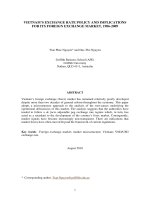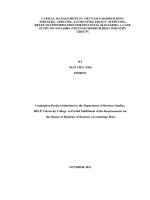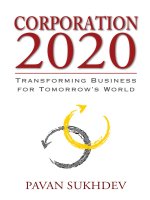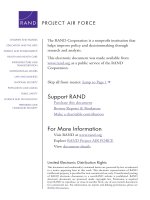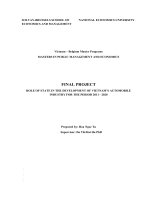VIETNAM''S SEARCH FOR TOMORROW
Bạn đang xem bản rút gọn của tài liệu. Xem và tải ngay bản đầy đủ của tài liệu tại đây (2.79 MB, 64 trang )
<span class="text_page_counter">Trang 1</span><div class="page_container" data-page="1">
Vietnam's Search for Tomorrow
</div><span class="text_page_counter">Trang 2</span><div class="page_container" data-page="2"><small>Vietnam's Search for Tomorrow</small>
Table of contents
<b>Top Country Trends</b>
Rise of Digital Rural ConsumersOn-demand Economy
The Smart Shopper
</div><span class="text_page_counter">Trang 3</span><div class="page_container" data-page="3"><small>Vietnam's Search for Tomorrow</small>
Vietnam has one of the fastest-growing Internet economies in Asia*.
<small>There are 68 million Internet users in Vietnam in 2020 and it is forecast to grow to 75.7 million by 2023*. More than 90% of Vietnam’s internet users connect to the Internet primarily through their mobile phones*. They communicate with their families, friends and colleagues, entertain themselves, learn new skills and become more productive. Increasingly, they also buy products, learn how to manage money and follow the latest health trends.</small>
<small>Internet access is now affordable for large segments of the population and consumer trust in digital services has improved significantly. Services that were previously limited to a few people are now almost universally accessible. e-commerce logistics, once a challenge, has turned into a business opportunity for both startups and established players. Digital payments are rapidly gaining popularity. </small>
<small>Consumers are also learning to stay informed and updated with the latest trends, thanks to the Internet. Information that was once difficult to obtain is now available at the tap of a screen. They are researching more and more online and increasingly turning to the Internet to make informed decisions on what brands and products to buy. </small>
<small>Covid-19 has made consumers reluctant to step out of their homes even after Vietnam eased social distancing measures. This has further accelerated the transition of users from offline to online, leading to complex digital journeys and heightened consumer expectations. As people make decisions about what to do, or what to buy, keeping up with them has become the need of the hour. It has encouraged traditional businesses to embrace digital and switch their focus to acquiring new customers online and driving engagement. This has provided customers with more choices and channels for purchase. </small>
<small>In the midst of all this, marketers are also faced with the challenge of clearly understanding what matters most to consumers in their moments of need, so brands can be present at the right place, at the right time, with the right information.</small>
<small>With Google’s </small><b><small>“Vietnam’s Search for Tomorrow”</small></b><small> report, we offer the latest insights to help marketers better shape their journeys and deliver what matters most to consumers.</small>
</div><span class="text_page_counter">Trang 4</span><div class="page_container" data-page="4"><small>Vietnam's Search for Tomorrow</small>
On-demand Economy
Popularity of on-demand services has seen immense growth in recent years
Top Country Trends
Rise of Digital Rural Consumers
Rural Vietnam will drive the next phase of the Internet economy boom
The Smart Shopper
There’s a marked increase in online product research before purchase
Health-conscious Consumer
Adoption of a healthy lifestyle has been a rising trend fora few years, but the Covid-19 pandemic has added impetus
</div><span class="text_page_counter">Trang 5</span><div class="page_container" data-page="5"><small>Vietnam's Search for Tomorrow</small>
<b><small>Vietnam's Search for Tomorrow</small></b>
Rise of Digital
Rural Consumers
</div><span class="text_page_counter">Trang 6</span><div class="page_container" data-page="6"><b><small>Rise of Digital Rural Consumers</small></b>
Metros continue to dominate the online landscape in terms of spending. But rural Vietnam, where more than half of the country’s population resides, is an untapped market and has seen high Internet penetration in recent years. The primary driversof this growth include the government’s universal smartphone programme to reach 100% of the population with subsidised devices and one of cheapest data packages in the region.
In the coming years, Non-Metros are poised to grow twice as fast as Metros. This increase of users coming online, getting familiar with the Internet and incorporatingit into their daily routines will mean that - for the first time - they can have accessto products and services readily available online.
spent on the Internet economy in Metros in 2019 (per capita) vs. $79 in Non-Metros
Convenience, value
Access to products and services
<b>What drives Internet economy adoption?</b>
<small>* Cities that are defined as Metros in Vietnam: Hanoi and Ho Chi Minh City</small>
Beyond Metros are poised to grow twice as fast as Metros
<small>User engagementConvenience & valueProductivity</small>
<b><small>GMV growth2019-2025</small></b>
Vietnam is seeing strong growth in its Internet economy, both in Metros* and rural areas.
</div><span class="text_page_counter">Trang 7</span><div class="page_container" data-page="7"><b><small>Rise of Digital Rural Consumers</small></b>
of people in rural Vietnamhave Internet access, of which91% access the Internet daily
There has been significant
growth in Internet penetration in
rural Vietnam
The Internet has become a bridge in
providing the resources rural consumers require to meet their needs and wants
<b>% of searches outside urban* Vietnam:</b>
jobs and education beauty and personal care health
<small>* Cities that are defined as urban in Vietnam: Hanoi, Da Nang, Ho Chi Minh and Can Tho</small>
</div><span class="text_page_counter">Trang 8</span><div class="page_container" data-page="8"><b><small>Rise of Digital Rural Consumers</small></b>
Search is the most commonly used tool by rural consumers when seeking information about product categories
Rural users use Search to:
products and brands
<b>Discover</b>
unknown products
<b>Validate</b>
purchase decisions
<b>They also depend on Searchto make purchase decisions</b>
<b><small>Source: Google Market Insights, “SEA Search User Insights,” 12,240 urban and non-urban users were surveyed</small></b>
45% of rural consumers use Search to learn more about products
</div><span class="text_page_counter">Trang 9</span><div class="page_container" data-page="9"><b><small>Rise of Digital Rural Consumers</small></b>
Rural users also love YouTube
Relevant, easily accessible content is the key driver for its preference over TV.It is also seen as a tool for rural Vietnamese to groom themselves for success
of rural Vietnamese use YouTube every week, and 62% use it daily
<b><small>Sources: Google SEA Search User Insights, Vietnam</small></b>
of rural Vietnamese say YouTube
teaches new skills and knowledge
of them findonline contentmore interestingor engaging in comparison to TV
say they prefer YouTube over TV because they have immediate access to the most updated content online
</div><span class="text_page_counter">Trang 10</span><div class="page_container" data-page="10">Implications for businesses
<b><small>Rise of Digital Rural Consumers</small></b>
With increased smartphone usage and high Internet penetration, rural Vietnam is a prime market for growth. Rural users are
increasingly turning to the Internet for communication, education, self-development and entertainment.
Marketers need to align their message with these categoriesto appeal to this target audience. They need to leverage the aspirations of rural Vietnamese and tailor their message to
showcase how their products and services can help them achieve their goals. They could curate content by interests, skills or
Content must feel useful, relevant and create an emotional connection. Brands should also consider tailoring separate communications for rural and urban audiences to increase resonance and purchase conversion.
</div><span class="text_page_counter">Trang 11</span><div class="page_container" data-page="11"><small>Vietnam's Search for Tomorrow</small>
On-demand Economy
<b><small>Vietnam's Search for Tomorrow</small></b>
</div><span class="text_page_counter">Trang 12</span><div class="page_container" data-page="12"><b><small>On-demand Economy</small></b>
Since the start of Covid-19 and Vietnam’s swift response, consumers are choosing to stay at home and order in. Across Vietnam, searches for on-demand services have seen immense growth. Vietnamese are increasingly using the Internet to shop, manage finances and health, seek entertainment and learn. This has encouraged traditional industries to embrace digital to cater to their needs.
“buy online Vinmart”
“buy Big C online”
“buy online emart”
“aeon shop online”“order Coopmart online”
<small>“mua hàng online Vinmart”“mua hàng Big C online”</small>
<small>“mua hàng online emart”“Aeon shop online”</small>
<small>“đặt hàng Coopmart online”</small>
</div><span class="text_page_counter">Trang 13</span><div class="page_container" data-page="13"><b><small>On-demand Economy</small></b>
Vietnamese are now looking for
speed and convenience when they shop. Searches for delivery services and
same-day delivery are rising rapidly
</div><span class="text_page_counter">Trang 14</span><div class="page_container" data-page="14"><b><small>On-demand Economy</small></b>
Education is going online. Gen-Z*
is increasingly turning to the Internetto maximise learning, share resources,find answers and get additional tutoring
<b>On-demand Access To Education</b>
<b>YoY growth in “online learning” </b>
<small>*Gen-Z are defined as those born between 1996 and 2005</small>
<b>Rising search terms for online learning:</b>
“online learning for class 2 to 12”
“online learning material portals”
“learn math online”
“learn languages online”
“online test”
<small>“học tiếng [Anh/Trung/Nhật/Hàn] online”“học toán online”</small>
<small>“cộng học liên trực tuyến”“học online lớp [2.12]”</small>
<small>“trắc nghiệm online”</small>
<b><small>On-demand Economy</small></b>
</div><span class="text_page_counter">Trang 15</span><div class="page_container" data-page="15">increase in the download of finance apps as consumers shift from
in-branch to online transactions
Users also want to learn how to managetheir money better
<b>YoY growth in searches:</b>
<b><small>Sources: App Annie, VN Finance Categories, August 2019 vs July 2020;</small></b>
<b>On-demand Money Management</b>
Given the economic uncertainties caused
by Covid-19, financial worries have increased. People are turning to the Internet for financial management options
</div><span class="text_page_counter">Trang 16</span><div class="page_container" data-page="16"><b>On-demand Access To Funds</b>
With people preferring to staying indoors, online cash-related searches have seen immense growth among consumers
<b>Rising search termsfor online cash:</b>
“online cash within a day”
“trustworthy online cash”
“quick cash online”
“online cash monthly installment loan”
“online cash 24/24”
<small>“vay tiền online trả góp hàng tháng”“vay tiền online cấp tốc”</small>
<small>“vay tiền online uy tín”</small>
<small>“vay tiền online nhanh trong ngày”</small>
<small>“vay tiền online 24/24”</small>
</div><span class="text_page_counter">Trang 18</span><div class="page_container" data-page="18">Vietnamese are also growing more healthconscious. Many are searching for apps and wearables that enhance well-being
<b>On-demand Health Management</b>
<b>surge in “health wearables” </b>
</div><span class="text_page_counter">Trang 19</span><div class="page_container" data-page="19">Implications for businesses
<b><small>On-demand Economy</small></b>
Due to Covid-19, there has been a rapid influx of consumers coming online for on-demand services. They are looking for convenience and fulfilment of their needs on a real-time basis. To remain relevant and drive results such as brand awareness, new leads or sales, traditional businesses will need to respond to consumer shifts and embrace digital.
Today, being online is a requirement and no longer a value-added service. Businesses that have understood this and embraced digital transformation have thrived. Brands need to use data and
technology to enhance their product and channel capabilities to reach their audience. They can also encourage more usage with a simple and intuitive e-commerce site, customer education about their services and prompt order fulfillment.
</div><span class="text_page_counter">Trang 20</span><div class="page_container" data-page="20"><b><small>On-demand Economy</small></b>
<b>Example: How a mattress retailer</b>
<b>revamped its product strategy</b>
The mattress is a product category that relies heavily on in-store traffic to allow customers to experience the product before purchase. Vua Nệm, one of Vietnam's leading mattress brands, faced low demand for mattresses and significant revenue decline during post-Tet and the nationwide stay-home order.
The brand, however, realised that there was a rising search and concern
for personal and family health. Vua Nệm strategized to capture attention with its value-added services of mattress, sofa and drapes cleaning to generate leads.The campaign launched in mid-February, at the height of demand for personal hygiene and health-related products. The extra service alone brought in a revenue uplift of 15%.
<b>Vua Nệm generated </b>
<b>15% increase in revenue from its value-added cleaning services alone during the national </b>
<b>Covid-19 social </b>
<b>distancing measures</b>
<b>35k 21% 15%</b>
Quality leads for newly launched service
Converted
service alone
</div><span class="text_page_counter">Trang 21</span><div class="page_container" data-page="21"><b><small>On-demand Economy</small></b>
<b>Example: Beauty brand drove sales</b>
<b>with Search with e-commerce</b>
When Covid-19 forced people to stay at home, millions of consumers moved from offline to online experiences. CPG brands in Vietnam faced an urgent need to expand their retail and digital partnerships. They had to react swiftly and create a compelling online presence.
In a programme piloted in Vietnam with Shopee, Google used signals and data to help L'Oréal drive consumers who are using Search with the intent to buy to their e-commerce store. It also measured lower-funnel performances and was successful in shifting some offline trade activities to digital.
<b>L'Oréal developeda digital partnershipto drive traffic to its e-commerce site</b>
Traffic to Shopee
<b>+8%</b>
</div><span class="text_page_counter">Trang 22</span><div class="page_container" data-page="22"><small>Vietnam's Search for Tomorrow</small>
The Smart Shopper
<b><small>Vietnam's Search for Tomorrow</small></b>
</div><span class="text_page_counter">Trang 23</span><div class="page_container" data-page="23"><b><small>The Smart Shopper</small></b>
Shopping has evolved significantly across Vietnam since growth in Internet access and the advent of Covid-19
Growth in touchpoints, channels and choices has meant that consumers are browsing and purchasing products, both in the online and offline world, whatever they need or want. Consumers are also using online tools available for research and inspiration before they buy. Not only do they want products of the highest quality, but they also want an extremely convenient purchase experience.
of Vietnamese spend time
researching products online before making a purchase decision
</div><span class="text_page_counter">Trang 24</span><div class="page_container" data-page="24"><b><small>The Smart Shopper</small></b>
Online product research dominates offline
product research across key product categories
<small>78% 73% 72% 67% 65% 63% 62% 62% 58% 55% 54% 52% 52% 50%22% 27% 28% 33% 35% 38% 38% 38% 42% 45% 46% 48% 48% 50%</small>
<b>62% consumers do online research on average</b>
Online
62%
</div><span class="text_page_counter">Trang 25</span><div class="page_container" data-page="25"><b><small>The Smart Shopper</small></b>
Convenience is the main driver for choosing to buy online and offline, but it has different definitions depending on the channel used
Top reasonsto shop offline:
Top reasonsto shop online:
Need product(s) immediately
Wanted to see/touch/try the product
Better price/deal/promotion in-storeDon’t trust product(s) online
Product delivery freeDetailed product infoEasier process than going in-store
Price/deal/promotion
</div><span class="text_page_counter">Trang 26</span><div class="page_container" data-page="26"><b><small>The Smart Shopper</small></b>
of Vietnamese have used
Search and YouTube in the past week to browse and buy
products online
For many Vietnamese, the search for a product primarily starts online
<b>Shoppers go to Google Search more than anywhere else to:</b>
Look for an item
seen somewhere <sup>Discover or find a new </sup>item or product
Discover or find
a new brand <sup>Get helpful suggestions</sup>
<b>Touchpoints that prompt consumers to shop:</b>
Vietnamese shoppers often go to Google Search first for discovery
</div><span class="text_page_counter">Trang 27</span><div class="page_container" data-page="27"><b><small>The Smart Shopper</small></b>
Trending ideas and inspirationsearches in 2020
</div><span class="text_page_counter">Trang 28</span><div class="page_container" data-page="28"><b><small>The Smart Shopper</small></b>
Personalised search
queries for products that cater to unique needs or address specific concerns are on the rise
“baby formula for developing weight”
140%
YoY<small>“sữa tăng cân cho bé”</small>
“baby food for 5 months baby”
60%
YoY<small>“bột ăn dặm cho bé 5 tháng”</small>
“baby shower gel for rash”
200%
YoY<small>“sữa tắm trị rôm sảy cho bé”</small>
“face wash for + [skin condition]”
50%
YoY<small>“sửa rửa mặt cho + [loại da]”</small>
“[hairstyles] + for round faces”
110%
YoY<small>“[kiểu tóc] + cho mặt trịn”</small>
<b>?</b>
</div><span class="text_page_counter">Trang 29</span><div class="page_container" data-page="29"><b><small>The Smart Shopper</small></b>
YoY increase in searches for
“shopping”-related videos on YouTube <sup>YoY growth in searches for “which </sup>product to buy” (“mua gì”) videos
56%
<b>product review categories:</b>
mobile phonefood
YouTube is the platform for consumers to
research and shop on. Vietnamese users turn to it to learn more about a product and find
inspiration on what brands to buy
<b><small>The Smart Shopper</small></b>
</div><span class="text_page_counter">Trang 30</span><div class="page_container" data-page="30">Implications for businesses
<b><small>The Smart Shopper</small></b>
Today’s shoppers are smart. They are increasingly going online to catch up on the latest trends, and research and purchase products. They are also engaging with brands that address their real-time needs.
For marketers, making sense of how to engage their target customer has never been trickier. Meeting them every step of the way is the only way brands can differentiate themselves. Every day, millions of people turn to Google to find, discover and research the right brand and product for their needs. According to Ipsos/Google SEA Search User
before purchasing at a brick-and-mortar store.
Brands in digitally less mature categories (where consumers do less research and buy online) should use digital channels to promote their offline store. For categories with a higher level of digital maturity (higher online research and online buy), an engaging and holistic marketing strategy is needed as consumers can convert at any time and at any touchpoint.
For brands, it is important to be discoverable and useful, and reach the consumer. Marketers will also have to find innovative and effective ways of keeping audiences engaged and retain customers.
</div><span class="text_page_counter">Trang 31</span><div class="page_container" data-page="31"><b><small>The Smart Shopper</small></b>
<b>Example: New product launch.</b>
Share on competitors’ keywords
Oppo strategized to launch its flagship device, Reno 3, by appearing when people searched for Oppo branded keywords or competitors’ keywords on both Google and YouTube Search.
<small>Oppo reno 3</small>
</div><span class="text_page_counter">Trang 32</span><div class="page_container" data-page="32"><small>Vietnam’s search for tomorrow</small>
Health-conscious Consumer
<b><small>Vietnam's Search for Tomorrow</small></b>
</div>


